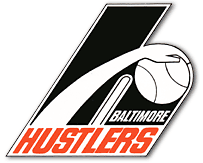
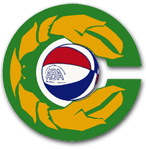
  |
Baltimore Hustlers/ClawsYear of existence: 1975 (folded on October 20, 1975)
|
In the summer of 1975, the Memphis Sounds franchise reached the end of the line in Tennessee after five seasons of utter futility. The team was sold to a shadowy group of seven Maryland businessmen, who immediately moved it to Baltimore.
Things did not go well from the very start. On August 24, 1975, ABA Commissioner Dave DeBusschere yanked the team away from the Maryland investors, ruling that the team was "undercapitalized." He awarded the franchise to a new group of investors in Memphis. Unbelievably, though, the Memphis group withdrew the very next day. DeBusschere then handed the club back to Baltimore. A $250,000 down payment to the ABA by the Baltimore group seemed to appease the ABA for the moment.
The new owners first named their team the "Baltimore Hustlers," and sent out a season ticket brochure using that moniker.
When the ABA league office got wind of the "Hustlers" nickname, it strongly objected. The ABA higher-ups felt that the name "Hustlers" had too many negative connotations, and strongly encouraged the Baltimore owners to choose another nickname. Soon after this directive, the "Baltimore Hustlers" quietly became the "Baltimore Claws." A second season ticket brochure was sent out, with the new nickname.
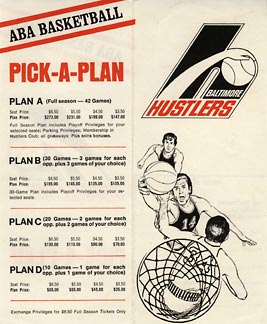 |
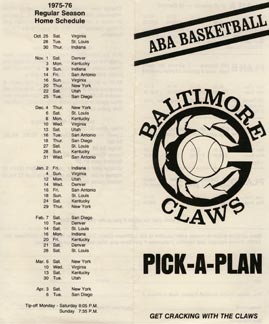 |
| A Tale of Two Brochures: It was definitely the "worst" of times for the ABA, at least in Baltimore. The team first tried to sell itself as the Baltimore "Hustlers." The ABA league office pondered the implications of this for about two seconds - and then informed the Baltimore owners that it should pick a new name. Immediately. The owners scrambled to put out a second brochure. This time they picked the name that stuck: the Claws. |
Not surprisingly, the reaction among Baltimore citizens was lukewarm - only a few brave souls signed up for the team's season ticket package.
Looking closer at the situation, Colonels co-owner John Y. Brown finally realized that the Baltimore owners were in far over their heads. They didn't know how to run a pro franchise, let alone raise $500,000 in a few days. A fed-up Brown roared into a meeting with the Claws and sold Issel to another interested team -- the Denver Nuggets. Just twenty-four hours earlier, the Nuggets had just learned that Marvin Webster, their promising rookie center, would be out for most of the year with hepatitis. As a result, the Nuggets were thrilled to pay the $500,000 to the Colonels for Issel. The Nuggets then sent forward Dave Robisch to the Claws as "window dressing" to make the arrangement look like a trade between Denver and Baltimore. Owens simply stayed put with the Colonels.
The Baltimore owners seemed unhappy with this arrangement. Incredibly, Claws President David Cohan told reporters that he had expected Baltimore to obtain four players from Denver in the deal - Robisch, Webster, and "two other solid players." Upon hearing this, Denver President Carl Scheer emphatically denied that he had agreed to send Webster - or any other players - to the Claws: "Marvin is not part of the deal. The only players involved are Issel and Robisch." Cohan still persisted in his claim for Webster, and even threatened to disband the Claws if he didn't get him: "I think we're going to have to make a serious decision if we don't get what we want. We have to have a representative team or we can't go through with [running the team]." He took his appeal to the ABA league office in New York. Not surprisingly, league officials ruled against Cohan and the other Baltimore owners - even though Issel was a bona fide all-star, it seemed outlandish that the Nuggets would give up $500,000, Robisch, Webster and two other players to get him.
After this fiasco, the Claws made one more deal: they sent veteran guard Rick Mount to the Utah Stars in exchange for Joe Hamilton (a small but extremely quick guard) and Tim VanBlommesteyn (a rookie guard and geology major from Princeton).
The Claws were left with a makeshift roster that included: Robisch, Hamilton, VanBlommesteyn, Mel Daniels (a former ABA all-star center), Chuck Williams (a capable veteran guard), Stew Johnson (a sharp-shooting eight-year ABA veteran), Claude Terry (a three-year veteran guard from the Denver Nuggets), Scott English (a 6-6 forward), and Paul Ruffner (a 6-11 pivotman who had previous ABA experience with the Pittsburgh Condors). In addition to Van Blommesteyn, the Claws had four other rookies: Mike Rozenski, Bob Rhodes, Tony Styles and Skip Wise.
Wise was an unusual case - during the 1974-75 college season with Clemson, the 6'3" guard averaged 18.9 points per game and become the first freshman ever to be named to the ACC Conference first-team. Strangely, Wise decided not to go back to Clemson - instead he signed a five-year, $700,000 no-cut contract with the Claws.
The team's coach was Joe Mullaney - a holdover from the team's previous existence in Memphis.
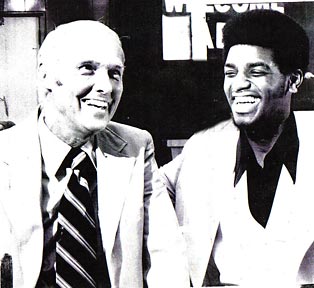 |
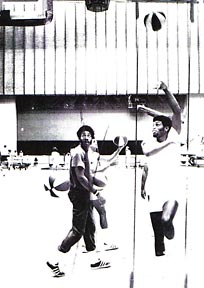 |
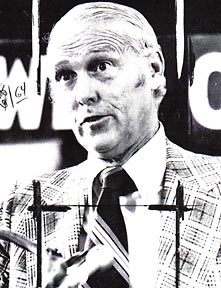 |
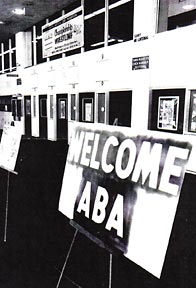 |
Here are some rare glimpses - complete with newspaper crop marks - into the brief and tumultuous existence of the Baltimore Claws.
At top left, Coach Joe Mullaney greets the Baltimore press with his prized rookie, Skip Wise. Wise jumped to the ABA Claws after his freshman year at Clemson, where he attained first-team all-ACC honors. Wise had played high school basketball in Baltimore, and the team felt he would be a gate attraction. Little did the coach or player know what was ahead of them with the troubled Claws. At top middle, Wise flips in a hook shot at an open Claws practice held at the Baltimore Civic Center. Claws players usually elected to practice even though they weren't being paid. The Claws only had used t-shirts available to the players - Claws practice jerseys would have broken the bank. At top right, Coach Mullaney addresses the media in the midst of the Claws' severe problems. Finally, Baltimore ownership was determined to create an elaborate advertising campaign to "welcome the Claws to town." Depicted in the photo at left is the massive media campaign. (photos courtesy of Richard Jewett) |
The Claws actually played three exhibition games.
On October 9, 1975, the Claws played the Virginia Squires in Salisbury, Maryland, at the Wicomico Youth and Civic Center. In front of 1,150 spectators, the Squires beat the Claws 131-121. Stew Johnson led the Claws in scoring with 21 points. Joe Hamilton scored 17 points for Baltimore, and Mel Daniels had 10 rebounds.
On October 11, Baltimore played the NBA Philadelphia 76ers at Cherry Hill, New Jersey. The Sixers beat the Claws 103-82, behind 28 points from Doug Collins.
Finally, on October 17, the Claws played the Squires in Emmitsburg, Maryland, at Knott Arena (on the campus of Mt. St. Mary's College). A "crowd" estimated at 500 fans watched the winless Claws trail by as many as 20 points in the second half before Virginia coasted to victory 100-88. Dave Robisch, in his first and only appearance for the Claws, hit only 1 of 6 field goals, and scored 2 points in 26 minutes of play. Skip Wise, Claude Terry and Bob Rhodes led the Claws in scoring with 12 points each. This was to be the last game ever for the franchise.
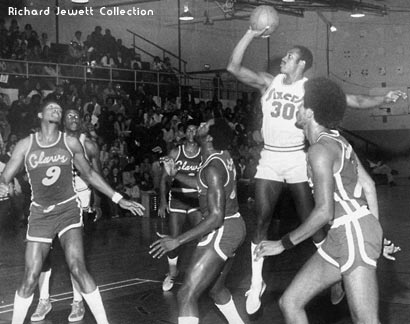 |
Here is the rarest of the rare: a photo showing the Claws in action.
It is from Baltimore's October 11, 1975 exhibition game against the NBA Philadelphia 76ers - one of only three games the Claws ever played. In a sight familiar to ABA fans, George McGinnis (#30) skies for his one-handed jumper against Claws players (from left to right) Mel Daniels, Chuck Williams, George Carter and Stew Johnson. This might be McGinnis' first game in the NBA after jumping to the 76ers from the ABA Pacers. It seems that the Claws have simply taken their Memphis Sounds jerseys (inherited from Memphis), and sewn a "Claws" patch on the front. The patch doesn't even really match the color of the uniform. Classic ABA! For a color action shot from this same game, go to eBay and type in "McGinnis Sportscaster Card" - you'll see a closeup of McGinnis driving against Mel Daniels. This color shot made the cover of Sports Illustrated - so the Claws were actually SI cover material! (Photo courtesy of Richard Jewett) |
In retrospect, it was amazing that the Claws even managed to play any games at all. Baltimore players and coaches were not being paid. Basketball Weekly writer Bob Ibach stated that : "Players, holed up in a downtown [Baltimore] motel, spoke of little meal money and no pocket money. Their practice T-shirts had rips under the arms. A car given to [Coach Joe] Mullaney by club owners was minus its four new tires. For exhibition games, half the uniforms were leftover red rags from the bad ol' Memphis days. All the warmup jackets were." Ibach also noted reports that one Claws player was dealing drugs, and that another spent three days in a Washington area jail for carrying a concealed weapon. The team took three days to bail the player out. Also, due to bad publicity, the Claws only managed to sign up 300 season ticket holders.
On October 16, 1975, upon hearing about the situation, Commissioner DeBusschere gave Claws President Cohan four days to send $500,000 to the ABA league office. This money would serve as a "performance bond" for team operations - it would be held by the league to cover current and future costs. Cohan and his six other original investors managed to pull together $250,000 of this amount. But the remaining $250,000 became hard to find. According to the Baltimore Sun, another $320,000 was being held in escrow by Bill Boucher, the executive director of the "Greater Baltimore Committee." Boucher was apparently holding the money on behalf of Baltimore Mayor William Schaefer and the City of Baltimore. Annoyed with the Claws' financial predicament and the pressure it had created, Boucher told a Baltimore Sun reporter: "What we have to determine is how to use civic money and whether it's responsible to use it and under what conditions." One of these conditions appeared to be Cohan's resignation as Claws president - which never happened.
While the ABA, Cohan and Boucher argued about the $500,000 needed to satisfy the ABA's upcoming deadline, the Claws players waited for the team to pay three days of back "per diem", at $20 per day. Claws management promised that the players' meal money would be paid, but the players kept on waiting.
To no one's surprise, the Claws missed the ABA's money deadline. Despite a last-ditch effort to gain another 24 hours of time, the ABA league office took immediate action. On October 20, 1975, five days before the start of the 1975-76 regular season, the league officially buried the Claws with this short statement issued by ABA Publicity Director Jim Bukata:
The American Basketball Association has terminated the Baltimore Claws franchise effective immediately.
Earlier this season, before Baltimore made application, we were prepared to go with nine financially strong franchises. The Baltimore franchise was available subject to certain financial commitments. The investors' group has failed to meet these commitments despite being granted additional time by the league to resolve their internal and financial problems. While we regret this turn of events, we owe it to the rest of the ABA fans and the players on the Baltimore roster to start our season with strong, financially sound clubs.
Each of our clubs will fill in the gaps on the schedule created by the loss of Baltimore. All will play 42 home and away games. A dispersal draft of Baltimore's players will be conducted by the league office in the near future.
While the Baltimore owners knew their own money situation and had to expect this drastic action, the players were shocked. An upset Mel Daniels told the Baltimore Sun:
It just seems unbelievable. I've been around the ABA for nine years and felt this would be the most solid year and now this happens. We worked hard and wanted something good to happen with this team. The guys feel it is part of our lives that has been swooped away. We tried hard to keep it together by working real hard in practice even when we weren't getting paid. But now it's all over and we're all down in the dumps.
Coach Joe Mullaney also expressed his feelings:
I'm disappointed. But I feel sorry mostly for the players. Coming just before the start of the season, a lot of them will have a hard time winning jobs.
While Coach Mullaney and his players were resigned to their fate, the Baltimore owners actually considered legal action against the ABA. Team president Cohan, an attorney, pointed to a special provision in the ABA league bylaws. That provision stated that no team could be shut down before receiving at least 10 days notice - and the Claws had not received the required 10 days. Based on this provision, Cohan and his partners threatened to file an injunction request with the courts. It granted, the injunction would have prohibited any ABA teams from competing until the Claws were reinstated. But, when the Baltimore owners heard that the ABA and the City of Baltimore would counter the injunction request with their own legal actions, the Claws owners finally backed down and gave up.
The Claws' office at the Baltimore Civic Center was padlocked by the owners of the arena, because the Claws' owners refused to pay any more bills.
Daniels' stellar eight-year ABA career ended on this note, as he decided to retire rather than play for another ABA team.
In a special Baltimore Claws dispersal draft, Robisch and Ruffner went to the Spirits of St. Louis (the Spirits then traded Robisch to San Diego), Johnson went to the San Diego Sails, Terry went to the Denver Nuggets, Williams went to the Virginia Squires (the Squires then traded him to Denver), English went to the Indiana Pacers, and Hamilton went back to the Utah Stars. George Carter was not picked by any team, but eventually signed with the Stars.
Nobody missed the Baltimore Claws.
Claws 1975 Preseason Uniform |
Claws 1975 Prototype Uniform |
Thanks to Richard Jewett, Frank Amtmann, Brian Clark and Josh Poore for their valuable contributions to this page.